Attacks on the Dortmund-Ems canal
The role of Bomber Command in the early years of the war was unclear even at the Air Ministry; should efforts be mainly against selective targets of German industry (oil was the first priority) along with all types of communication lines and even forests and autumn crops, or should the emphasis be attacking the airfields from which the Luftwaffe was operating and aircraft factories, even though the latter were often distant and difficult to find?

"I did my first flight and first tour on Hampdens. A beautiful aeroplane to fly, terrible to fly in! Cramped, no heat, no facilities where you could relieve yourself. You got in there and you were stuck there. The aeroplane was like a fighter. It was only 3 feet wide on the outside of the fuselage and the pilot was a very busy person. There were 111 items for the pilot to take care of because on the original aircraft he had not only to find the instruments, the engine and all that, but also he had all the bomb switches to hold the bombs. – Wilfred John 'Mike' Lewis
Bomber Command itself was in a parlous state after the Battle of France in which it had played a supporting role and taken a mauling on many occasions using its Fairey Battles, Bristol Blenheims and Handley Page Hampdens, none of which could carry a significant bomb load. Bombing accuracy at this stage of the war was poor - nearly all night raids were carried out by small numbers of aircraft sent to numerous targets, each crew being required to find its own way but with navigation being by "dead reckoning" using forecast winds and astro sightings major navigational errors were common. If the target area was found the bomber had to fly around for some time to establish the exact location or method of attack by means of map reading or the light of the moon, though darkness and the German black-out often concealed the target and increasingly dense and accurate flak and searchlights forced the bombers to higher altitudes which further compromised bombing accuracy. However hitting the aqueduct over the Glane required precision bombing, the few attacks by small numbers of relatively lightly loaded Hampdens which took place in 1940 caused very little damage to the canal area such that the target was ignored for the next three years.
1940
25/26th July: the Mittelland Canal which joins the Dortmund-Ems near Munster was attacked, one Hampden of 83 squadron was lost. Damage to the canal area unknown.
12/13 August: 11 Hampdens of 49 and 83 squadrons were ordered to make a low-level attack on the canal. The German defences around the target area had been increased so aircraft were subjected to intense light flak. 2 aircraft were shot down but 8 Hampdens managed to drop their bombs causing damage which was still hampering barge traffic a month later. One of the successful aircraft was flown by Flt Lt Learoyd, his determination in pressing home his attack earned him the first Bomber Command VC of the war. His commendation reads:
Air Ministry, 20th August, 1940.
The KING has been graciously pleased to confer the VICTORIA CROSS on the undermentioned officer in recognition of most conspicuous bravery :-
Acting Flight Lieutenant Roderick Alastair Brook Learoyd 37860 :-
This officer, as first pilot of a Hampden aircraft, has repeatedly shown the highest conception of his duty and complete indifference to personal danger in making attacks at the lowest altitudes regardless of opposition. On the night of 12th August, 1940, he was detailed to attack a special objective on the Dortmund Ems Canal. He had attacked this objective on a previous occasion and was well aware of the risks entailed. To achieve success it was necessary to approach from a direction well known to the enemy, through a lane of especially disposed anti-aircraft defences, and in the face of the most intense point-blank fire from guns of all calibres. The reception of the preceding aircraft might well have deterred the stoutest heart, all being hit and two lost. Flight Lieutenant Learoyd nevertheless made his attack at 150 feet, his aircraft being repeatedly hit and large pieces of the main plane torn away. He was almost blinded by the glare of many searchlights at close range, but pressed home this attack with the greatest resolution and skill. He subsequently brought his wrecked aircraft home and, as the landing flaps were inoperative and the undercarriage indicators out of action, waited for dawn in the vicinity of his aerodrome before landing, which he accomplished without causing injury to his crew or further damage to the aircraft. The high courage, skill and determination, which this officer has invariably displayed on many occasions in the face of the enemy sets an example which is unsurpassed.
21/22 August: 42 Hampdens were sent to attack a range of targets in Holland and Germany, only 29 found their targets and bombed. A Hampden of 144 squadron was the only RAF loss that night whilst attacking the D-E canal.
1943
By mid-1943 the shape and modus operandi of Bomber Command had changed appreciably. The Hampden had been phased out and even its replacement, the Vickers Wellington which had given Bomber Command a new cutting edge was becoming operationally obsolete. Heavy bombers capable of carrying a much heavier payload were now the mainstay of Bomber Command squadrons: the Short Stirling, the Handley Page Halifax and most notably the Avro Lancaster. From its inception the Lancaster could carry almost four times the weight of bombs as the Hampden though it took a crew of seven to carry out its deadly purpose. During its three year operational life the original 14000 lb payload of mixed bombs increased to the capability to carry a single 22000 lb "Grand Slam" bomb.
Following Churchill's enquiry about resurrecting the attacks on the canal, 617 squadron were tasked with the first operation for 3 years against this target. The squadron had made its name the previous May with the daringly successful low-level attack on the dams supplying the Ruhr so they were thought to be the obvious candidates but once again the canal proved a harder nut to crack.
14/15 September: 8 Lancasters of 617 squadron set out to attack the banks of the canal, however whilst over the North Sea it was reported that the target was obscured by fog so the force was recalled. Disaster struck when the Lancaster flown by Flt Lt D J H Maltby, one of the Dambuster's force crashed into the sea killing all the crew.
15/16 September: following the previous day's postponed operation, a further 8 aircraft under the command of the new Commanding Officer Sqd Ldr. Holden took off again to attack the Dortmund-Ems Canal. The crew were the same as those on the previous night, except that Flt Lt Martin took the place of Sqd Ldr. Maltby. Six Mosquito aircraft from 605 and 418 Squadrons accompanied the aircraft to attract ground fire and act as fighter cover. The visibility over the target was very bad, a thick haze preventing accurate location of the target. On the inward journey Sqd Ldr Holden’s aircraft was seen to be hit by light flak and to crash. Flt Lt Allsebrook took over the direction of the attack and dropped his bomb. Flt Lt Knight (another of the Dambuster pilots) called up on R/T and stated that his two port engines were stopped, he asked for permission to jettison and return to Base but nothing further was heard from this aircraft. (Knight stayed with his aircraft whilst his crew baled out but was unable to escape himself). Flt Lt Wilson asked for permission to attack but nothing further was heard from him, as was the case with P O Divall, both were hit by light flak. No contact could be made with Flt Lt Allsebrook, also hit by flak so Flt Lt Martin took over command of the remaining aircraft. P/O Rice could not identify the canal area owing to poor visibility, so he came back over the coast and jettisoned. Flt Lt Shannon dropped his bomb, which was seen to explode on the tow path on the East bank. Only three aircraft returned from this raid. The Mosquitoes patrolled the target area for one and a half hours and during this time no enemy fighters were seen and few searchlights. All of the Mosquitoes returned safely.
In just two days 617 squadron lost 36 of their crew members whilst causing no damage to the canal banks. These heavy losses, combined with those incurred in the Dams raid confirmed that low-level attacks on German targets were not viable with heavy bombers. It was to be another 12 months before this target received further attention from Bomber Command. The Dortmund-Ems canal was to take an exacting toll in Commanding Officers before the war's end.
1944
23/24 September: 136 Lancasters and 5 Mosquitoes of 5 Group (which was destined to be the "specialist" Group for attacks against the canal) attacked the canal near Ladbergen with a further 113 Lancasters sent to bomb the nearby Munster-Handorf airfield intended as a diversionary raid. A Window spoof operation was also sent across the North Sea, plotted by the Germans from 22.39 hours but it attracted only minor fighter attention. The target was once again obscured by cloud, but 7/10ths coverage meant the op. still went ahead and this time with considerable success. 617 squadron scored 2 direct hits with the 12000 lb Tallboy bombs at the opening of the raid, the remaining aircraft caused a 6 mile stretch of the canal to be drained though with the loss of 14 Lancasters, more than 10% of the attacking force.
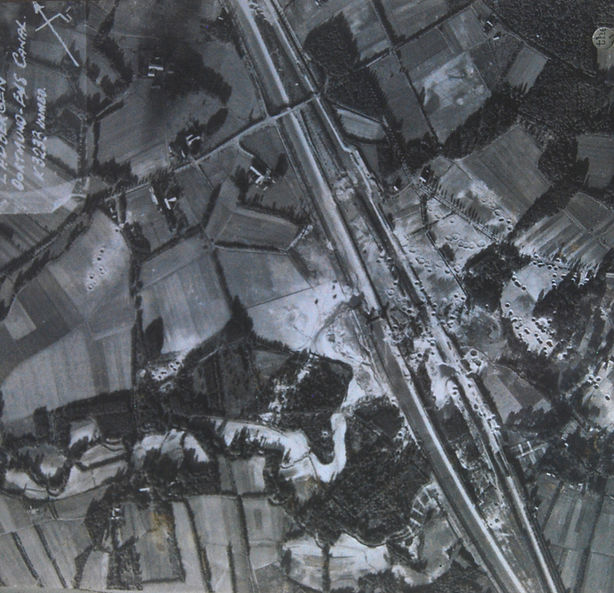
A photo-reconnaissance picture taken on 2 October showing the effectiveness of the attack. The assessment carried out states:
Both branches of the canal are still impassable 9 days after the attack. Eastern (old) branch: a heavy calibre bomb has torn away a section of the embankment. The water is draining through this breach and is running overland into the river. In consequence of this a section of 370 yards of the canal is competely dry and impassable to shipping.
Western (new) branch: a similar breach is evident in the embankment of this branch of the canal. The water is as before draining away into the river Glane and a stretch of 450 yards is completely dry.
Target area: One 200' barge is high and dry at the S. end of the W. branch and two smaller boats appear to be beached. At the N. end of the target one 200' barge appears to be beached and another, partly aground, is at an acute angle across the canal.
So at last a worthwhile result but at a high cost. Plotting of the Ladbergen raid by German radar had started at 21.52 hours, they were plotted continuously for 40 minutes from 22.39 hours as they approached their target. Nachtjagd fighters, some of which had been chasing bombers attacking another target now concentrated on the Ladbergen force though none reached them until the bombing had begun. The first serious opposition the bombers met was from light flak guns protecting the airfield, which fired intense and accurate barrages. Over the target area 7 encounters were reported with Nachtjager though the bombers were chased home well into the Netherlands. The Kommandeur of NJG1, Heinz Wolfgang Schnaufer shot down 3 of the Ladbergen Lancasters and 1 of the Munster-Handorf aircraft. Hptm Dietrich Schmidt claimed a Lancaster destroyed, but he was shot down shortly afterwards by a Mosquito of 219 squadron as he entered the circuit at Dusseldorf airfield.
463 squadron lost 2 Lancasters that night, LM223 (JO-P) flown by P/O Sydney Staples on his first operation, and LM309 (JO-V) flown by F/O Jack Lindquist on his third. Nobby Blundell, 467 and 463 squadrons' historian and groundcrew, wrote in "They flew from Waddington" of the loss of these two aircraft "Other crews reported the two a/c collided mid-air over target". All the crew of LM233 were killed and 4 of LM309 though Lindquist survived to be a PoW. In a letter that he wrote to me, Lindquist stated that he had been shot down, corroborated in part by at least one claim made by a Nachtjager for a 463 squadron Lancaster.

Jack's letter saying that "I also was shot down on the D E canal raid on 23rd Sept. 44". Below are two relevant pages from the ORBs (Operation Record Books) for 463 squadron for that night showing that Staples and Lindquist were missing. The details of sortie column confirms that most bombed from around 8 to 9000' and that visibility over the target was excellent underneath the cloud base.
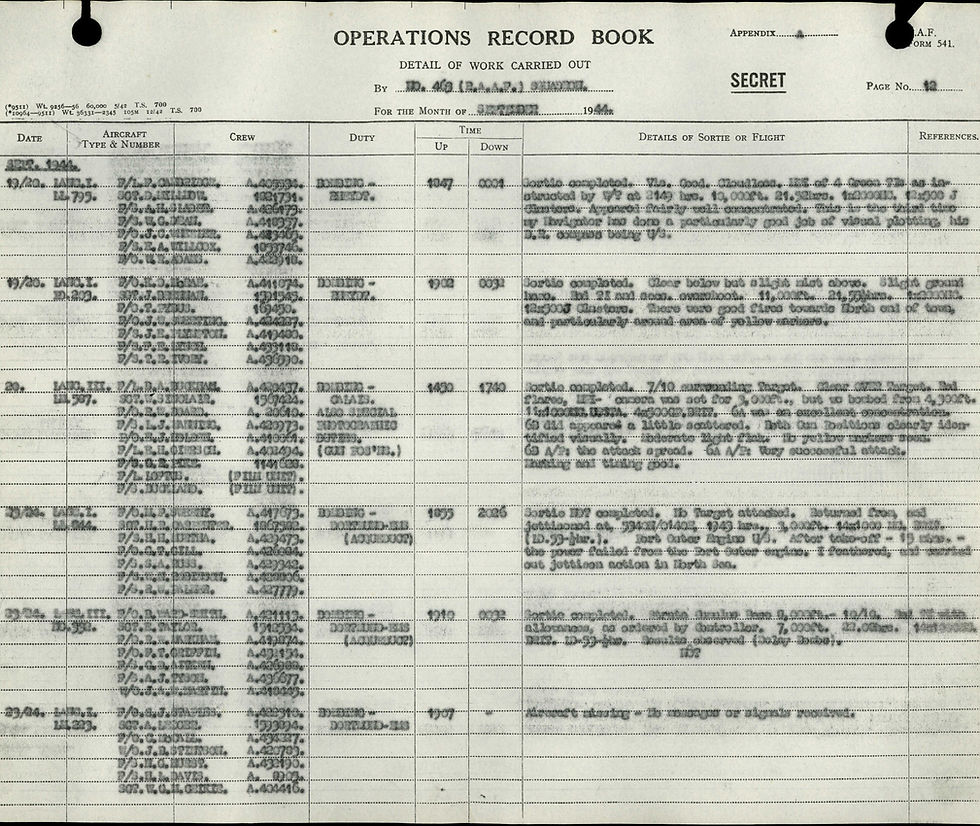
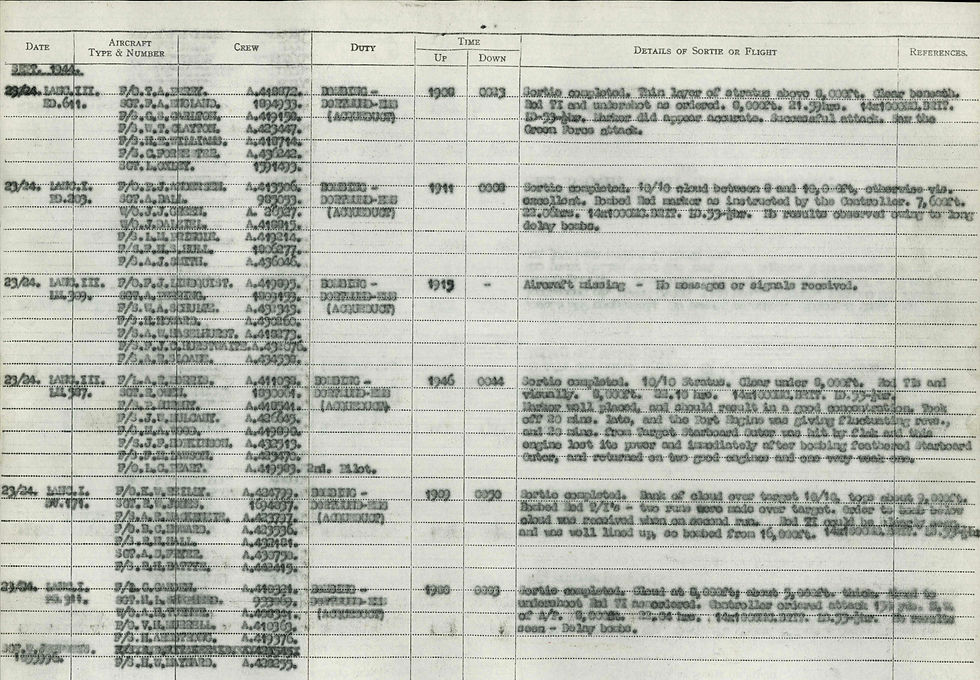
Below are two extracts from the 467 squadron ORBs for the same operation which differ in reports of visibility and of receiving instructions from the Controller to bomb below cloud base of 8000'. F/O Cowan speaks of the destruction of quite a few aircraft by fighters over the target, whilst Flt Lt Purser observed at least six aircraft heading home over the North Sea with their navigation lights burning.

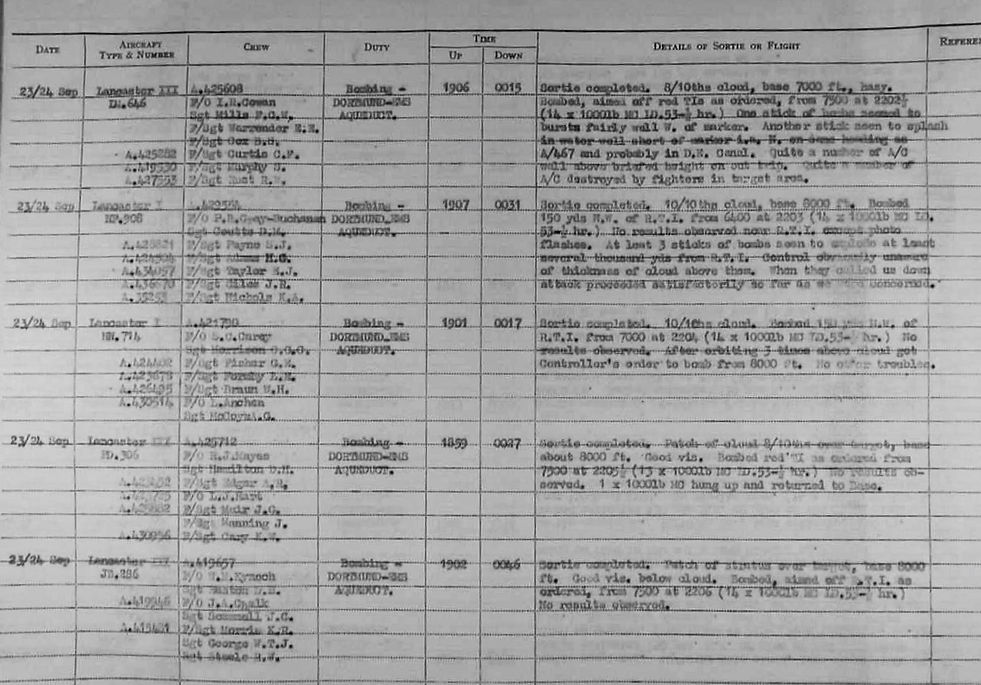
4/5 November: 174 Lancasters and 2 Mosquitoes of 5 Group re-visited the D-E canal after it became clear that the Germans had partly repaired the section damaged during the raid in September. H-hour, the time of the attack, was between 19.19 and 19.40 hours, set at this time so that the operation was over before the moon rose though a strong westerly wind encountered en route to the target denied the bomber stream the cloud cover that was hoped for.
100 Group was a specialist force based in Norfolk which flew aircraft in support of bombing operations, some of them fighters such as Mosquitoes acting as intruders, some of them heavy bombers equipped mainly with sophisticated electronic equipment designed to mask or screen the approach of the bomber stream or to interrupt the German radar and fighter controller's instructions.
On this particular evening a "Mandrel" screen began radiating 2 hours before H-hour in an attempt to hide the force's progress across the Netherlands however the Germans obtained a fix on the force as it had just left Yarmouth, giving the German controllers plenty of time to get their very sizeable numbers of night fighters in position all along the route, the first interceptions taking place near the Dutch coast at 18.57 hours, though another bomber force attacking Bochum took the brunt of the Luftwaffe attack aided by the fact that the fighter controllers had failed to get their aircraft in the right positions before the raid started, suffering only two attacks and four combats on the outward route.

A Boeing Fortress II of 214 squadron, part of 100 Group, responsible for Electronic Countermeasures (ECM) operations in support of the bomber stream.
The banks of the canal were again breached, water cascading into the lower farmland leaving barges stranded and the canal once again unusable.

Comments from the crews indicate what a successful attack this was:


...F/O Stewart was right, it was a well aimed attack!
6 November
The success of the previous attacks only two days earlier at Ladbergen were not to be repeated on this operation against the Gravenhorst/Mittelland section. The marking force experienced great difficulty in finding the target and only 31 of the 235 Lancasters bombed before the Master Bomber ordered the raid to be abandoned. It proved a costly night for such a futile operation, 9 Lancasters and 1 Fortress were lost, 63 crewmen being killed.
21 November
183 Lancasters renewed the attack against the Mittelland canal, this time with greater success for the canal banks were successfully breached such that water drained off over a 30 mile stretch, 59 barges were stranded on one short section alone.
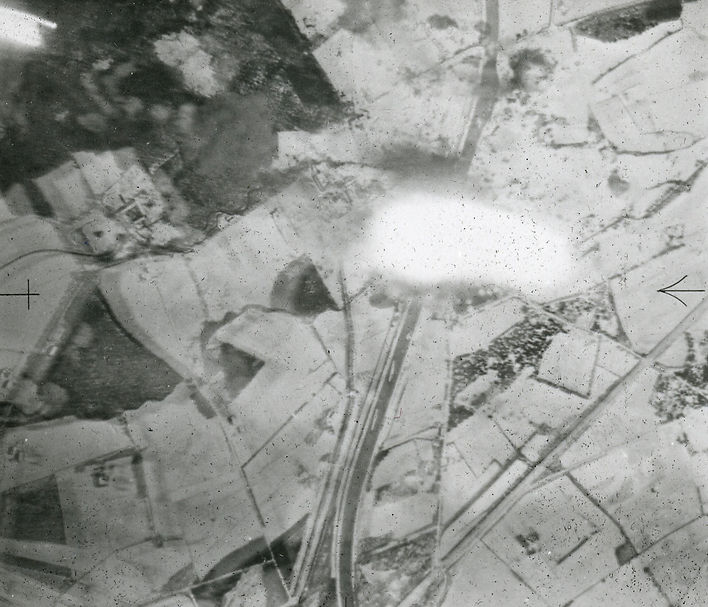
A direct hit on the Mittelland canal
Barges moving along the canal at the time of the attack
